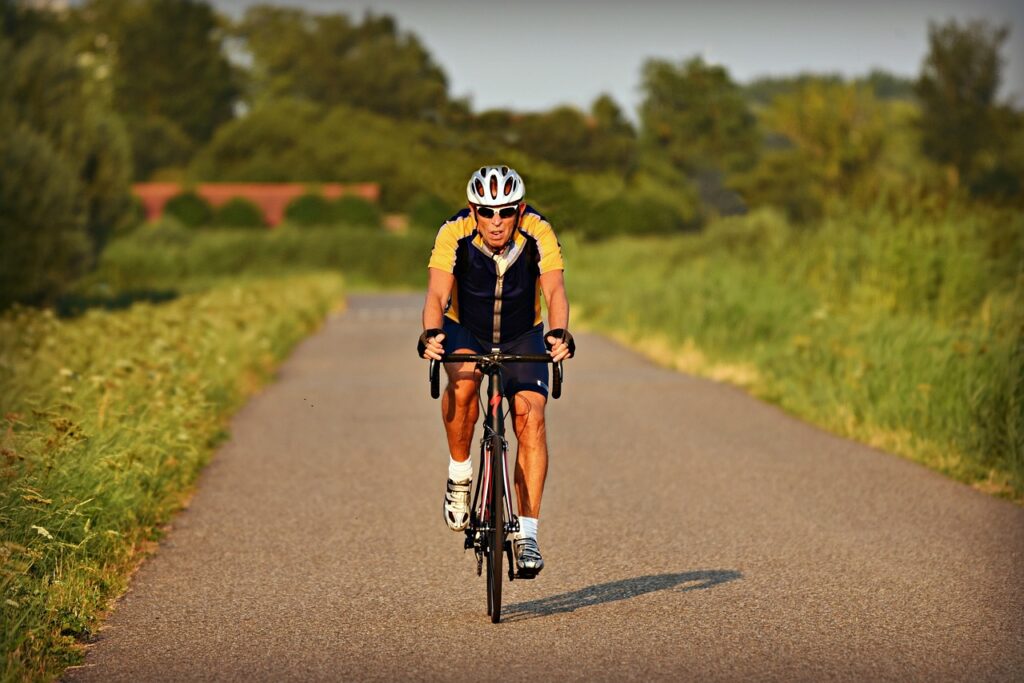Riding a bicycle is a timeless skill that brings a sense of freedom and adventure. Whether you’re a complete novice or returning to cycling after years, this comprehensive guide will walk you through the steps to confidently ride a bicycle. From choosing the right bike to mastering balance and safety, we’ve got you covered.
1. Choosing the Right Bicycle
Understanding Different Types of Bicycles
When you decide to ride a bicycle, the first step is choosing the right one. Bicycles come in various types, each designed for specific purposes. Mountain bikes are ideal for rugged terrains, road bikes are perfect for smooth pavements, and hybrid bikes offer a balance of both. Identify your primary riding environment to select the best bike for your needs.
Finding the Perfect Fit
A properly fitting bicycle is crucial for comfort and control. When selecting a bike, ensure the frame size matches your height. Stand over the bike and check that there’s a slight clearance between you and the top tube. Adjust the seat height so your leg is almost fully extended when the pedal is at its lowest point. A well-fitted bike will make learning to ride much easier.
2. Essential Gear for Biking
Helmets and Protective Gear
Safety should always come first when you ride a bicycle. Invest in a good-quality helmet that fits snugly and complies with safety standards. Additional protective gear such as knee and elbow pads can provide extra protection, especially for beginners prone to falls.
Comfortable Clothing and Footwear
Wearing the right clothing can enhance your cycling experience. Opt for breathable, moisture-wicking fabrics that keep you cool and dry. Padded cycling shorts can reduce saddle discomfort on longer rides. Choose closed-toe shoes with a firm sole to ensure a good grip on the pedals.
3. Learning the Basics
Getting Familiar with Your Bike
Before you start riding, familiarize yourself with your bicycle. Learn the functions of the brakes, gears, and pedals. Practice using the brakes to understand their responsiveness. Understanding your bike’s mechanics will give you confidence as you begin to ride a bicycle.
Mounting and Dismounting
Mastering the art of mounting and dismounting your bike is essential. Start by positioning the bike on a flat surface. To mount, stand on one side, hold the handlebars, and swing your leg over the saddle. To dismount, slow down, apply the brakes, and step off the bike by swinging your leg back over.
4. Finding Your Balance
Practicing Balance
Balancing is the foundation of learning to ride a bicycle. Begin by sitting on the bike with both feet on the ground. Practice pushing off and gliding while keeping your feet close to the ground. Gradually lift your feet onto the pedals and try short bursts of pedaling. Balance improves with practice, so don’t get discouraged if it takes a few tries.
Using Training Wheels
For those who find balancing particularly challenging, training wheels can provide additional stability. Training wheels are a great way to build confidence and get accustomed to the feel of riding. Once you’re comfortable, you can gradually adjust them higher until you no longer need them.
5. Mastering Pedaling
Starting and Stopping
Learning how to start and stop smoothly is crucial. To start, place one foot on the ground and the other on a pedal raised to a two o’clock position. Push off with the grounded foot while simultaneously pressing down on the pedal. To stop, gently squeeze the brakes and lower one foot to the ground to steady yourself.
Pedaling Techniques
Efficient pedaling involves a smooth, circular motion rather than just pushing down. Focus on pulling up as well as pushing down. This technique, known as “pedal strokes,” can help maintain a steady speed and reduce fatigue. Practice makes perfect, so keep working on your pedaling technique.
6. Understanding Gears
The Purpose of Gears
Gears on a bicycle help you manage your effort and maintain a comfortable pedaling rhythm, regardless of the terrain. Low gears make it easier to pedal uphill, while high gears are suitable for flat or downhill rides. Familiarize yourself with shifting gears smoothly to enhance your riding experience.
Shifting Gears
To shift gears, use the shifters located on the handlebars. Practice shifting while pedaling on a flat surface to get a feel for the changes. Avoid shifting gears while stationary, as this can damage the bike. Understanding how to use gears effectively will make your ride smoother and more enjoyable.
7. Steering and Maneuvering
Steering Basics
Steering a bicycle requires a gentle touch. Keep your hands relaxed on the handlebars and use slight movements to change direction. Practice riding in a straight line and making gentle turns. As you gain confidence, try weaving between cones or other markers to improve your steering skills.
Handling Turns
When approaching a turn, slow down and shift your weight slightly to the side you’re turning toward. Lean your bike into the turn while keeping your body upright. Look in the direction you want to go, as this will naturally guide your steering. With practice, you’ll be able to handle turns smoothly and confidently.
8. Riding in Different Terrains
Smooth Pavements
Riding on smooth pavements is the easiest terrain for beginners. Practice on bike paths, sidewalks, or quiet streets with minimal traffic. Focus on maintaining a steady speed and practicing the skills you’ve learned so far.
Uneven and Off-Road Surfaces
As you become more confident, try riding on uneven surfaces like gravel paths or grassy areas. These terrains require better balance and control. Start slowly and be prepared for a bumpier ride. Off-road riding can be challenging but also adds an element of excitement to your biking experience.
9. Safety on the Road
Following Traffic Rules
When you ride a bicycle on the road, follow the same traffic rules as motorists. Always ride in the same direction as traffic, obey traffic signals, and use hand signals to indicate your turns. Being predictable and visible to drivers enhances your safety.
Defensive Riding
Defensive riding means being aware of your surroundings and anticipating potential hazards. Keep a safe distance from parked cars, as doors can open unexpectedly. Watch out for pedestrians, other cyclists, and road obstacles. Staying alert and cautious will help you avoid accidents.
10. Riding with Others
Group Riding Etiquette
Riding in a group can be fun and motivating. Follow group riding etiquette to ensure safety and harmony. Ride in a single file on narrow roads, communicate your intentions to fellow riders, and be mindful of the group’s pace. Group rides are a great way to socialize and improve your riding skills.
Family Rides
Cycling with family, especially children, requires extra precautions. Make sure everyone is wearing helmets and understands basic road safety. Choose safe, family-friendly routes like bike paths or parks. Family rides are a wonderful way to spend quality time together while staying active.
11. Maintaining Your Bicycle
Basic Maintenance
Regular maintenance keeps your bicycle in good working condition. Check the tire pressure, brakes, and chain regularly. Keep your bike clean and lubricate the chain to prevent rust. Basic maintenance ensures a smooth and safe ride every time you head out.
Addressing Common Issues
Learn to address common issues like flat tires or loose brakes. Carry a basic repair kit with tools, a spare tube, and a pump. Knowing how to fix minor problems yourself can save you time and hassle during rides.
12. Staying Motivated
Setting Goals
Setting achievable goals can keep you motivated to ride regularly. Whether it’s riding a certain distance, mastering a new skill, or participating in a cycling event, goals give you something to strive for. Celebrate your achievements to stay inspired.
Joining Cycling Clubs
Joining a cycling club or group can provide support, encouragement, and camaraderie. Cycling clubs often organize rides, offer tips, and create a sense of community. Being part of a group can make your cycling journey more enjoyable and fulfilling.
13. Health Benefits of Cycling
Physical Fitness
Cycling is an excellent form of exercise that improves cardiovascular health, builds muscle, and enhances flexibility. It’s a low-impact activity, making it suitable for all ages and fitness levels. Regular cycling can help you stay fit and healthy.
Mental Well-being
Cycling also benefits mental health by reducing stress, anxiety, and depression. The rhythmic motion and outdoor exposure can boost your mood and provide a sense of freedom. Riding a bicycle can be a great way to clear your mind and enjoy nature.
14. Exploring Your Surroundings
Discovering Local Trails
Cycling allows you to explore your local area in a new way. Look for bike trails, parks, and scenic routes near you. Exploring new paths keeps your rides interesting and helps you discover hidden gems in your community.
Planning Cycling Adventures
As you gain confidence and experience, plan longer cycling adventures. Whether it’s a weekend ride to a nearby town or a multi-day tour, cycling adventures offer a unique and rewarding way to travel. Plan your route, pack essentials, and enjoy the journey.
15. Encouraging Others to Ride
Teaching Friends and Family
Share the joy of cycling by teaching friends and family how to ride a bicycle. Be patient and supportive, offering guidance and encouragement. Seeing others experience the freedom of cycling can be incredibly rewarding.
Promoting Cycling in Your Community
Get involved in promoting cycling in your community. Advocate for better cycling infrastructure, participate in bike-friendly events, and encourage local businesses to support cycling initiatives. Promoting cycling helps create a safer and more welcoming environment for all riders.
16. Cycling Competitions and Events
Participating in Races
Once you’re comfortable on a bike, consider participating in cycling races or events. Races can be competitive or recreational, catering to different skill levels. Joining a race challenges you and provides a sense of accomplishment.
Charity Rides
Charity rides combine the joy of cycling with the opportunity to support a good cause. These events raise funds for various charities and offer a sense of community. Participating in a charity ride is a fulfilling way to contribute to a meaningful cause while enjoying your passion for cycling.
17. Advanced Cycling Techniques
Climbing Hills
Climbing hills requires strength and endurance. Shift to a lower gear, maintain a steady pace, and focus on your breathing. Practice makes hill climbs less daunting, and over time, you’ll conquer even the steepest slopes with confidence.
Descending Safely
Descending hills can be exhilarating but requires control. Keep your hands on the brakes, lean back slightly, and maintain a steady speed. Avoid sudden braking to prevent skidding. Descending safely ensures you enjoy the thrill without compromising your safety.
18. Customizing Your Bike
Upgrading Components
As you become more experienced, you might want to upgrade your bike components for better performance. Consider upgrading the saddle, pedals, or handlebars to suit your preferences. Customizing your bike can enhance comfort and make your rides more enjoyable.
Personalizing Your Ride
Personalize your bike with accessories like lights, bells, and baskets. Add a splash of color with decals or handlebar tape. Personalizing your ride makes your bike unique and reflects your style.
19. Cycling in Different Weather Conditions
Riding in the Rain
Riding in the rain requires extra caution. Equip your bike with fenders and wear waterproof clothing. Slow down and increase your braking distance. Riding in the rain can be challenging but also adds a new dimension to your cycling experience.
Cold Weather Cycling
Cycling in cold weather requires proper gear to stay warm and comfortable. Layer your clothing, wear insulated gloves, and protect your face with a balaclava. Cold weather cycling can be invigorating and keeps you active year-round.
20. Celebrating Your Progress
Reflecting on Your Journey
Take time to reflect on your cycling journey. Celebrate the progress you’ve made, the skills you’ve learned, and the experiences you’ve had. Reflecting on your journey provides a sense of achievement and motivates you to keep riding.
Setting New Goals
As you reach your initial goals, set new ones to continue challenging yourself. Whether it’s riding longer distances, exploring new routes, or participating in events, new goals keep your cycling experience exciting and rewarding.
Conclusion
Learning to ride a bicycle opens up a world of freedom and adventure. With the right approach, patience, and practice, anyone can master the art of cycling. Embrace the journey, enjoy the ride, and experience the countless benefits that come with the simple joy of riding a bicycle. Whether you’re cycling for fitness, exploration, or just for fun, the road ahead is full of possibilities. Happy cycling!





